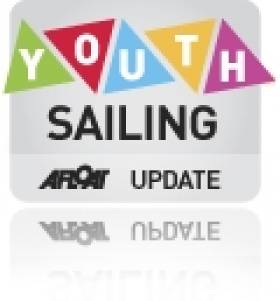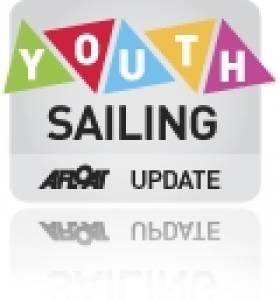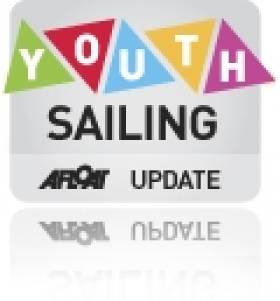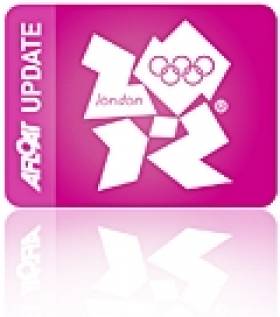Displaying items by tag: Laser 4.7
Irish Junior Success at UK Laser Championships
Dun Laoghaire's Conor O'Beirne of the Royal St George YC won the Laser 4.7 UK Championships in Abersoch at this week-long regatta. Sailed in a variety of conditions from heavy to medium shifty conditions with a few light races thrown in for good measure O'Beirne finished with a 10-point margin and a race to spare. The event included an Irish representation of eight sailors, all of whom were competive in the fleet. Aisling Keller of LDYC challenged for the lead up to the final day, finishing a close third overall. At the mid-point, Irish sailors occupied five of the top ten places. Sorcha Ni Shuilleabhain of KYC finished in the top ten with Eric Ruigrok RSC placing 15th. Overall the Irish sailors finished strongly with most well inside the top half which bodes well for Irish Laser sailing into the future.
In the Laser Radial fleet, Daragh O'Sullivan of KYC put together a very strong series, including three bullets, to finish fifth overall. Dan O'Beirne from RStGYC also sailed a consistent series with string of top ten finishes to place 9th overall.
The event also featured top twenty placings for Cian Cahill, RStGYC and Ryan Glynn, BYC with the majority of the rest of the Irish sailors showing well in the Gold Fleet. Considering the Radial class included two GBR Olympic campaigners in the fleet of almost 100 along with the RYA-funded GBR Radial squad of 14 sailors, Irish Radial sailors have a lot to be happy about.
The championships consisted of a 12 race series with the best 10 races to count over six days competition.
Laser 4.7 UK Champs Overall
| Series Place | Sail No | Helm | M/F | Crew | Category | Tally | UK Nats |
|---|---|---|---|---|---|---|---|
| 1 | 183231 | Conor O'BEIRNE | G | J | 4.7-042 | I | |
| 2 | 174568 | Will CREAVEN | G | Y | 4.7-010 | W | |
| 3 | 193620 | Aisling KELLER | L | G | J | 4.7-046 | I |
| 4 | 202458 | Hamish ECKSTEIN | G | J | 4.7-023 | ||
| 5 | 179795 | Sam MCKAY | G | Y | 4.7-014 | ||
| 6 | 191850 | Georgia BOOTH | L | G | J | 4.7-027 | |
| 7 | 195118 | Tom JOESBURY | G | J | 4.7-030 | W | |
| 8 | 201701 | Sophie HERITAGE | L | G | J | 4.7-039 | |
| 9 | 165292 | Joe WOODLEY | G | J | 4.7-008 | ||
| 10 | 198435 | Sorcha NI SHUILLEABHAIN | L | G | Y | 4.7-049 | I |
| 11 | 193494 | Jack ROCKETT | G | J | 4.7-029 | ||
| 12 | 151286 | Simon WEATHERSPOON | G | J | 4.7-005 | ||
| 13 | 161777 | Caitlin TWEEDLE | L | G | Y | 4.7-007 | |
| 14 | 186262 | Josh ATHERTON | G | J | 4.7-020 | ||
| 15 | 197362 | Erica RUIGROK | L | G | J | 4.7-048 | I |
| 16 | 196999 | David HAW | G | J | 4.7-032 | ||
| 17 | 197899 | Karyna MANUEL | L | G | J | 4.7-034 | |
| 18 | 180292 | Emily GENT | L | G | J | 4.7-015 | |
| 19 | 185978 | Rupert DANIELS | G | Y | 4.7-019 | ||
| 20 | 193576 | Craig CAMPBELL | G | Y | 4.7-045 | ||
| 21 | 198827 | Jacob FARREN-PRICE | G | J | 4.7-036 | ||
| 22 | 186695 | Sophie TAYLOR | L | G | Y | 4.7-021 | S |
| 23 | 19617 | Hanna BRANT | L | S | J | 4.7-017 | |
| 24 | 192861 | Andrew LEVIE | G | Y | 4.7-044 | I | |
| 25 | 130583 | Verity HOPKINS | L | S | Y | 4.7-003 | |
| 26 | 189216 | Scott O'SULLIVAN | G | J | 4.7-043 | I | |
| 27 | 178210 | Sam TWEEDLE | S | J | 4.7-013 | ||
| 28 | 149321 | Harry COBBY | S | Y | 4.7-009 | ||
| 29 | 196243 | Lucy BURROWS | L | G | Y | 4.7-047 | I |
| 30 | 119333 | Fred WARREN-SMITH | S | Y | 4.7-002 | ||
| 31 | 185655 | Sam CHILTON | S | J | 4.7-018 | ||
| 32 | 153740 | Chelsea JACKSON | L | S | Y | 4.7-006 | W |
| 33 | 191038 | Sam THOMAS | S | J | 4.7-025 | W | |
| 34 | 189370 | Edward DOWNES | S | Y | 4.7-024 | W | |
| 35 | 197705 | Aimee O'BRIEN | L | S | J | 4.7-033 | |
| 36 | 187491 | Ollie TAIT | S | J | 4.7-022 | ||
| 37 | 191693 | James EADY | S | J | 4.7-026 | ||
| 38 | 180777 | Harriet PHILO POWELL | L | S | J | 4.7-016 | |
| 39 | 201836 | Tom FENEMORE | S | J | 4.7-040 | ||
| 40 | 199271 | Fiona HARRINGTON | L | S | Y | 4.7-037 | |
| 41 | 191794 | James WILLIAMS | S | Y | 4.7-035 | W | |
| 42 | 200748 | Tai THOMAS-DAY | S | J | 4.7-038 | ||
| 43 | 192517 | Rosie POVALL | L | S | Y | 4.7-028 | |
| 44 | 136198 | Steph HARDING | L | S | Y | 4.7-050 | |
| 45 | 186068 | Poppy DANIEL | L | S | J | 4.7-041 | |
| 46 | 196381 | Melissa BRADY | L | S | J | 4.7-031 | S |
| 47 | 176716 | Tadhg O'FARRELL | S | J | 4.7-011 | ||
| 48 | 133335 | Millie HOPKINS | L | S | J | 4.7-004 | |
| 49 | 118465 | Melissa COULTON-MCCULLOUGH | L | S | J | 4.7-001 |
Seafra Guilfoyle is Laser 4.7 National Champion
| Rank | SAIL NO | HELM | CLUB |
|---|---|---|---|
| 1st | 199421 | Seafra Guilfoyle | Royal Cork YC |
| 2nd | 189216 | Darragh O'Sullivan | Kinsale YC |
| 3rd | 182600 | Finn Lynch | National YC/BSC |
| 4th | 196981 | Sian Kneafsey | National YC |
| 5th | 200637 | Ruairi Finnegan | Waterford Harbour SC |
| 6th | 198561 | Tadgh Donnelly | National YC |
| 7th | 198552 | Ryan Glynn | Ballyholme YC |
| 8th | 189215 | Eoin Curran | East Down YC |
| 9th | 197315 | Cillian McGreer | Howth YC |
| 10th | 198518 | Dara O'Shea | Kinsale YC |
| 11th | 190759 | Conor Murphy | Kinsale YC |
| 12th | 188016 | Patrick Young | National YC |
| 13th | 188084 | John Durcan | Royal Cork YC |
| 14th | 198555 | Cian Byrne | Royal Cork YC |
| 15th | 183948 | Ross O'Sullivan | Kinsale YC |
| 16th | 180596 | Katherine Geoghegan | Royal Cork YC |
| 17th | 196982 | Emma Cooney | National YC/LDYC |
| 18th | 166433 | Max van der Lee | Royal St George YC |
| 19th | 198551 | Alex Delamer | Howth YC |
| 20th | 173059 | Michael Magowan | Tralee Bay SC |
| 21st | 192852 | Rónan Jones | Wexford Harbour BTC |
| 22nd | 184757 | William Shanahan | National YC |
| 23rd | 195271 | Vikki Cudmore | Royal Cork YC |
| 24th | 191306 | David Hopkins | Cushendall S&BC |
| 25th | 198435 | Sorcha Ni Shuilleabhain | Kinsale YC |
| 26th | 193591 | Susie O'Neill | National YC |
| 27th | 183231 | Dan O'Beirne | Royal St George YC |
| 28th | 198563 | Dara O'Connor | Carlingford Lough YC |
| 29th | 198562 | James Eggers | Royal St George YC |
| 30th | 174830 | Helen Mc Parland | Carlingford Lough YC |
| 31st | 193531 | William Potterton | Waterford Harbour SC |
| 32nd | 197894 | Nathaniel Gillett | Royal St George YC/LDYC |
| 33rd | 180353 | Patrick Cahill | Royal St George YC |
| 34th | 192861 | Andrew Levie | Lough Derg YC/KYC |
| 35th | 190758 | Julie Power | Royal St George YC |
| 36th | 190584 | Luke, Murphy | Wicklow SC |
| 37th | 196741 | Claire Lambert | National YC/LDYC |
| 38th | 196732 | Cliodhna O'Regan | Kinsale YC |
| 39th | 175654 | Laura McGettigan | Royal Irish YC |
| 40th | 178694 | Florence Lydon | Baltimore SC/Schull CC |
| 41st | 180324 | Tallula Dunne | National YC |
| 42nd | 31908 | Roddy Fitzpatrick | Royal St George YC |
300 Top Junior Sailors Bound for Dublin Bay
Over 300 sailors will compete in Dublin Bay in seven different classes (Laser Radial, Laser 4.7, 420, Feva, Topper, SL16 and Optimist). For youth sailors, this event is the most important in the annual calendar as it is the decider for the top Irish sailors to compete internationally during 2011 and is the pathway for future Olympic sailors. Podcast with Olympic Team Manager James O'Callaghan here.
The 420 fleet is already in situ as the Leinster Championships were held over Easter and the girls team Emma Geary and Niamh Connolly won the event in style. This team is the only 420 crew to qualify internationally for a place on the Irish team to compete in the ISAF Youth Worlds in Zadar, Croatia and will be looking to win next weekend to secure this honour.
Dublin Bay will host the 2012 ISAF Youth World Championships and this year's ISA Mitsubishi Youth National event is an important test event with representatives from the international sailing authority visiting Dun Laoghaire to view plans and test logistics.
In addition to the 420 fleet the Laser radial fleet will also be competing to qualify to represent Ireland in Croatia. Philip Doran aged 17 from Courtown in Wexford is the current former under 17 World Champion in the Laser Radial fleet although the National title has eluded him so far. In the girls fleet it will be a toss up between Saskia Tidey (RIYC) and Sophie Murphy (Quoile YC) as both already have a national title each under their belts.

A fleet of top Optimists are expected. Photo: Bob Bateman
The younger Optimist fleet is also celebrating this week after two top 5 positions at the Easter Regatta in Braassemermeer, the Netherlands. In fact an Irish team has competed at this event for 23 years and this is the first time that Ireland has won the country prize. Sean Donnelly from Dun Laoghaire who finished fourth in Braassemermeer is also leading the Optimist fleet in the trials and will be anxious to hold on to first position during the ISA Mitsubishi Youth Nationals.
In other fleets, the laser 4.7 fleet is enjoying record numbers with many ex-Optimist and Topper sailors choosing this boat. Finn Lynch from Blessington and Seafra Guilfoyle from Cork will be firm favourites to win the class.
Overall Dublin Bay will be a spectacle of sail over the May Bank holiday weekend with light winds forecast.
Mitsubishi Motors have been a proud supporter of junior sailing in Ireland for the last 7 years. In recent years Ireland has had successes at youth level with winner of the girls under 21 Laser World Championships and a top 10 at the 2010 ISAF Youth Worlds and wins at the British National Optimist Championships.
Dinghy Sailor Finn Lynch Wins Laser 4.7 Prize
Irish youth sailing sensation Finn Lynch has won the Laser 4.7 prize sailing in Lake Garda in Italy this month, the win was recorded at his first international event since moving to the Laser class. Lynch from the National Yacht Club came tenth overall in a fleet of 230 competitive boats. Lynch, from Blessington, is reigning UK and Irish Topper Champion. He also finished second in the Topper worlds championships last season before moving to the Laser class.
Lynch's Dun Laoghaire club mate Tadgh Donnelly followed closely as seventh U16 sailor and 54th overall. In the Radials Rory Lynch and Philip Doran both finished in the top third of a fleet of 220 boats with some very good races during the event.
Podcast on youth sailing with Olympic team manager James O'Callaghan.
Bank Holiday Youth Champs to Expect 300
May Bank Holiday weekend (29 April – 02 May) over 300 sailors will compete in Dublin Bay in seven different classes (Laser Radial, Laser 4.7, 420, Feva, Topper, SL16 and Optimist). For youth sailors, this event is the most crucial in the annual calendar as it is the decider for the top Irish sailors to compete internationally during 2011 and is the pathway for future Olympic sailors.
Not only will the ISA Mitsubishi Youth Nationals over the May weekend be an important event for youth sailors it is also a major milestone for the organisers of the ISAF Youth Worlds 2012 as it offers them the opportunity to test drive the logistics of managing such a large event incorporating three clubs, three race courses and hundreds of volunteers.
'Dun Laoghaire has a proud reputation for hosting international events such as the biennial combined clubs Dun Laoghaire Regatta and numerous world championships. However in 2011 the ISA Mitsubishi Youth Nationals is of more significance as it gives us an opportunity to test our systems in advance of the ISAF Youth Worlds 2012.' stated Event Chairman Brian Craig.
Dun Laoghaire won the bid to host the ISAF Youth Worlds 2012 from 12-21 July when, in excess of 300 sailors and windsurfing champions from over 60 nations will participate. The granting of this prestigious sailing event to Ireland is a major boost to the sport and secures Ireland's position as an ideal location for hosting world class sailing events. It also establishes Dun Laoghaire as one of the prime major racing locations in the world, capable of running multiple classes and courses to the highest international standard.
'The Youth Nationals is a significant event on the racing calendar. It involves young sailors from all of the 'Olympic Pathway' classes, some of whom are competing for places on the team that will represent Ireland in the ISAF Youth Worlds later this year. In recent years Ireland has had successes at youth level with winner of the girls Laser World Championships a top 10 at the 2010 ISAF Youth Worlds and wins at the British National Optimist Championships.
Three hundred sailors from around the country are expected to compete for national youth and junior pathway titles and the Mitsubishi coaching grant during the event.
Northern Ireland Yacht Club Awarded Volvo RYA Champion Club Status
Carlingford Lough Yacht Club in Northern Ireland has been presented with the prestigious Volvo RYA Champion Club award. Carlingford Lough has been recognised for its very active racing programme focusing on the Laser 4.7, Radial and Topper classes. The club encourages and supports talented young sailors to develop and progress throughout the RYA Youth and Olympic programmes.
The presentation was held at the Yacht club's annual dinner dance and presentation at local Whistledown Hotel, Warrenpoint. Commodore, Michael McCann understands the importance of developing the club's youth sailors "We are all very delighted and proud to have been awarded the coveted Volvo Champion Club status. This achievement is a reflection of the great work, dedication and energy which has been put into youth and junior sailing in recent years.
While a number of senior club members have been involved along the way I must single out our past sailing secretary Dr Henry McLaughlin who worked to fulfil the arduous requirements necessary to gain this recognition. The Club would also like to thank Volvo and the RYANI for this award and we will continue to work with them to promote Championship level sailing in the region."
The club's junior training programme is run by 8 regular volunteers who are committed and dedicated to helping with the racing, training and the club's busy social programme. For the past three years the club has had five juniors in the RYA Volvo national squad and at the 2010 RYA Volvo Zone Home County Championships in Northern Ireland two of the members excelled both finishing in second place.
Carlingford Lough Yacht club is one of only 12 clubs in Northern Ireland and 171 nationwide to be awarded the esteemed Volvo RYA Champion Club status. Richard Honeyford, RYA High Performance Manager for Northern Ireland presented the club with the award "I am delighted to be presenting this award in recognition of the great work that Carlingford Lough Yacht Club has done to help young sailors to develop their racing skills. Following the success of British sailors at the Beijing Olympics, and with the 2012 Olympics fast approaching, we may well be training future Olympians here in Carlingford Lough"
The Volvo RYA Champion Club Programme aims to encourage young sailors and windsurfers at grassroots level to stay in the sport and learn to compete, while encouraging clubs to introduce youngsters to the sport and help develop their skills. The key challenge for the programme is to encourage more young people to start participating in sailing and then progress with their racing careers.
Now Carlingford Lough Yacht club has been awarded the Volvo RYA Champion Club status, the sailors will see increased levels of development advice and professional coaching including support from the RYA. Carlingford Lough will also have access to the recent commitment from Sport England of £1.1m to the RYA's flagship youth sailing initiatives, to further enhance club coach and volunteer development across England over the next three years.
Wallace, Murphy and Flynn Take Laser Titles on Belfast Lough
In the Standard Rig, Ronan Wallace (Wexford B & TC) took the title from Robert Espey (Ballyholme YC) and Stpehen Mc Lernon (Cushedall SC).
Annalise Murphy (National YC) won the Radial Championships from Philip Doran (Courtown SC) and Tiffany Brien (Ballyholme YC).
Annalise won 4 of the 8 races sailed including all three in the 16-20 knot breeze on Saturday. The National YC sailor becomes the first female sailor to take the Laser Radial Irish National title.
The 4.7 rig was won by John Flynn (Dungarvan SC) from Colm O Regan (Kinsale YC) and Stephen Duke (Courtown SC). The first girl in the 4.7 was Georgina Corbett (LDYC/NYC).
Irish Sailors Perform at Warnemunde
Ireland's Laser Radial sailors are making impressive headway in a huge Laser Radial fleet at the Warnemunde Woche regatta in Germany.
Rory Lynch has kept his head and posted two top five results so far to sit just inside the top ten in ninth overall, in the 144-boat fleet. Lynch could soon be joined by Courtown sailor Philip Doran who has posted similar results but is currently hampered by a black flag and is hanging on in 17th. Ross Vaughan is eight places further back and makes up the top three Irish sailors at this stage.
In the 66-boat Laser 4.7 fleet, Leo Hickey is the top Irish boat in 12th with Stephen Duke following in 33rd.
Racing continues today. The event website is HERE, with results hard to find, but HERE




































































